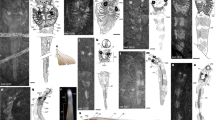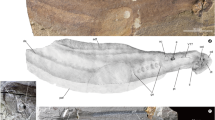Abstract
Widespread nowadays in freshwater and coastal seas of the cold and temporal zones, lampreys are a jawless vertebrate group that has been in existence for more than 300 million years but left a meagre fossil record. Only two fossil lamprey species, namely Mayomyzon pieckoensis1,2 and Hardistiella montanensis3,4,5, have been recognized with certainty from North American Carboniferous marine deposits6. Here we report a freshwater lamprey from the Early Cretaceous epoch (about 125 million years ago) of Inner Mongolia, China. The new taxon, Mesomyzon mengae, has a long snout, a well-developed sucking oral disk, a relatively long branchial apparatus showing branchial basket, seven gill pouches, gill arches and impressions of gill filaments, about 80 myomeres and several other characters that are previously unknown or ambiguous. Our finding not only indicates Mesomyzon's closer relationship to extant lampreys but also reveals the group's invasion into a freshwater environment no later than the Early Cretaceous. The new material furthers our understanding of ancient lampreys, bridges the gap between the Carboniferous ones and their recent relatives, and adds to our knowledge of the evolutionary history of lampreys.
This is a preview of subscription content, access via your institution
Access options
Subscribe to this journal
Receive 51 print issues and online access
$199.00 per year
only $3.90 per issue
Buy this article
- Purchase on Springer Link
- Instant access to full article PDF
Prices may be subject to local taxes which are calculated during checkout

Similar content being viewed by others
References
Bardack, D. & Zangerl, R. First fossil lamprey: A record from the Pennsylvanian of Illinois. Science 162, 1265–1267 (1968)
Bardack, D. & Zangerl, R. in The Biology of lampreys Vol. 1 (eds Hardisty, M. W. & Potter, I. C.) 67–84 (Academic, London, 1971)
Janvier, P. & Lund, R. Hardistiella montanensis n. gen. et sp. (Petromyzontida) from the Lower Carboniferous of Montana, with remarks on the affinities of the lampreys. J. Vertebr. Paleontol. 2, 407–413 (1983)
Lund, R. & Janvier, P. A second lamprey from the Lower Carboniferous (Namurian) of Bear Gulch, Montana (U.S.A.). Geobios 19, 647–652 (1986)
Janvier, P., Lund, R. & Grogan, E. Further consideration of the earliest known lamprey Hardistiella montanensis Janvier and Lund, 1983, from the Carboniferous of the Bear Gulch, Montana, U.S.A. J. Vertebr. Paleontol. 24, 742–743 (2004)
Grogan, E. D. & Lund, R. The geological and biological environment of the Bear Gulch limestone (Mississipian of Montana, USA) and a model for its deposition. Geodiversitas 24, 295–315 (2002)
Hardisty, M. W. & Potter, I. C. (eds). The Biology of Lampreys (Academic, London, 1974–82)
Zhu, Y. D. et al. Fauna Sinica: Cyclostomata, Chondrichthyes (Science Press, Beijing, 2001)
Bardack, D. & Richardson, E. S. Jr . New agnathous fishes from the Pennsylvanian of Illinois. Fieldiana Geol. 33, 489–510 (1977)
Janvier, P. Early Vertebrates (Clarendon, Oxford, 1996)
Janvier, P. The dawn of the vertebrates: Character versus common ascent in the rise of current vertebrate phylogenies. Palaeontology 39, 259–287 (1996)
Potter, I. C. & Hilliard, R. W. A proposal for the functional and phylogenetic significance of differences in the dentition of lampreys (Agnatha: Petromyzontiformes). J. Zool. 212, 713–737 (1987)
Barker, L. A., Morrison, B. J., Wicks, B. J. & Beamish, F. W. H. Potential fecundity of landlocked sea lamprey larvae, Petromyzon marinus, with typical and atypical gonads. Copeia 1998, 1070–1075 (1998)
Wicks, B. J., Barker, L. A., Morrison, B. J. & Beamish, W. H. Gonadal variation in Great Lakes sea lamprey, Petromyzon marinus, larvae. J. Great Lakes Res. 24, 962–968 (1998)
Briggs, D. E. G. & Kear, A. J. Decay of Branchiostoma: Implications for soft-tissue preservation in conodonts and other primitive chordates. Lethaia 26, 275–287 (1994)
Chang, M. M., Chen, P. J., Wang, Y. Q., Wang, Y. & Miao, D. (eds). The Jehol Biota (Shanghai Scientific and Technical Publishers, Shanghai, 2003)
Zhou, Z., Barrett, P. M. & Hilton, J. An exceptionally preserved Lower Cretaceous ecosystem. Nature 421, 807–814 (2003)
Wang, H. Z. (ed.) Atlas of the Palaeogeography of China (Cartographic Publishing House, Beijing, 1985)
Acknowledgements
We thank X. Wang for providing the fossils and information on their provenance and stratigraphic horizon; Z. Zhou for discussions and reading the manuscript; M. Zhu for providing information and discussions; M. Yang for the illustrations; and W. Gao for photography. This study was supported by the Chinese Academy of Sciences, the National Natural Science Foundation of China and the Asian–Swedish Research Partnership Program of the Swedish Research Council.
Author information
Authors and Affiliations
Corresponding authors
Ethics declarations
Competing interests
Reprints and permissions information is available at npg.nature.com/reprintsandpermissions. The authors declare no competing financial interests.
Rights and permissions
About this article
Cite this article
Chang, Mm., Zhang, J. & Miao, D. A lamprey from the Cretaceous Jehol biota of China. Nature 441, 972–974 (2006). https://doi.org/10.1038/nature04730
Received:
Accepted:
Issue Date:
DOI: https://doi.org/10.1038/nature04730
This article is cited by
-
The rise of predation in Jurassic lampreys
Nature Communications (2023)
-
Blood-sucking fish had flesh-eating ancestors
Nature (2023)
-
Study on the Jehol Biota: Recent advances and future prospects
Science China Earth Sciences (2020)
-
A sinemydid turtle from the Jehol Biota provides insights into the basal divergence of crown turtles
Scientific Reports (2015)
-
Facts and fancies about early fossil chordates and vertebrates
Nature (2015)
Comments
By submitting a comment you agree to abide by our Terms and Community Guidelines. If you find something abusive or that does not comply with our terms or guidelines please flag it as inappropriate.



